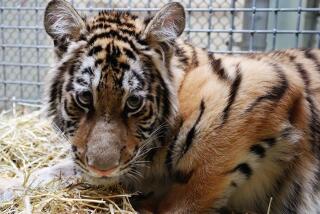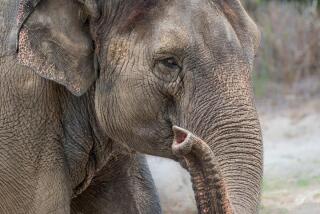San Diego Safari Park’s baby giraffe Kumi euthanized after being gored
A 5-month-old male giraffe born at the San Diego Zoo Safari Park was euthanized near the end of December after being gored in the stomach, probably by an antelope, said zoo spokeswoman Christina Simmons.
The giraffe, named Kumi, was born Aug. 6, 2018. He was in good health until he was discovered the morning of Dec. 29 with the gore wound. A veterinary assessment found that the wound couldn’t be treated, Simmons said, so animal care staff made the difficult decision to put him down.
The zoo announced Kumi’s passing in a statement posted Friday on Facebook.
The incident highlights the dangers that animals can encounter, even in a managed habitat, if they are to have any of the natural experiences they would have in the wild.
Kumi’s wound was consistent with being gored by an antelope, but there is no proof, Simmons said. The wounding wasn’t observed by animal care staff. And the location of the mother and the other giraffes at the time wasn’t known.
The zoo had no other details on what it described as a rare incident.
Giraffe mothers and other adults generally protect the young, Simmons said. And giraffes and antelopes generally get along in nature. These species are often found together, and communicate to each other, such as to warn of threats, Simmons said.
Because of this natural relationship, the species are placed together at the Safari Park under the San Diego Zoo Global’s Opportunities to Thrive standards, Simmons said. It aims to re-create natural behaviors and interactions of species, as well as supporting the health of the animals, Simmons said.
Diet, opportunities for animals to take care of themselves, and allowing animals choices when feasible are also important, Simmons said. Those learning opportunities inevitably involve some risk.
“It’s a balancing act,” she said.
“In natural habitats, animals are faced with stress. They’re eaten by predators, they run into challenges. We protect them a great deal in human-managed environments. But we do recognize that when you’re working toward conserving a species, you have to provide them with some of the same kinds of things they would normally experience in their natural habitat.”
Located southeast of Escondido, the Safari Park encompasses 1,800 acres, making it one of the largest zoos in the nation. By comparison, the San Diego Zoo’s Balboa Park location covers 100 acres.
Because of its size, the Safari Park is able to re-create landscapes that allow large animals the space to exhibit natural behaviors, such as herding, that are not feasible at smaller zoos.
“Animals that live in African plains, particular the big hoofed animals, normally live in multispecies groups,” Simmons said. “And so we work to maintain those animals in the Safari Park in those same herds, keeping them either with the same species or with very similar species. I’ve been to Africa myself, and you see a lot of interaction between the different herds.”
Re-creating those natural interactions is particularly important at the Safari Park, Simmons said. Animals are kept and bred there with the goal of release back into the wild. And the animals need to learn the skills of their wild relatives for introductions to be successful.
That recently happened with Eric the rhino, who was sent to Tanzania, she said. An 8-year-old black rhino, Eric was relocated last summer from the Safari Park to a conservation park in the Serengeti region.
“One of the reasons Eric was considered an excellent candidate for repatriation to a natural habitat is that he grew up in a large, multispecies habitat,” she said. “He was exposed to a lot of the same species he would run into in Africa.”
Kumi’s death will be reported to the proper regulatory agencies, Simmons said. The zoo regularly files reports on animal care to the U.S. Department of Agriculture.
Bradley J. Fikes reports for the San Diego Union-Tribune.
More to Read
Start your day right
Sign up for Essential California for news, features and recommendations from the L.A. Times and beyond in your inbox six days a week.
You may occasionally receive promotional content from the Los Angeles Times.






